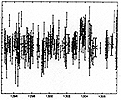For Educators

Make Your Own "Weather" Map
National Math Standards:
- Mathematics as Problem Solving
Students will develop and apply a variety of strategies to solve problems, with an emphasis on multi-step and non-routine problems. They will acquire confidence in using mathematics meaningfully. - Mathematics as Communication
The students will model the situation using a graphical method. They will clarify and reflect on their own thinking about mathematical ideas and situations. In addition, students will discuss, interpret and evaluate mathematical ideas. - Mathematics as Reasoning
Students will understand and apply reasoning processes with attention given to spatial skills and reasoning with graphs. - Mathematical Connections
Students will see math as an integrated whole. They will explore problems and describe results using graphical, physical and verbal models or representations. - Number and Number Relationships
Students will understand, represent and use numbers in the form of decimals in a real-world problem situation. In addition, students will represent numerical relationships in a one and two dimensional graph. - Statistics
Students will collect, organize and describe data. In addition, students will interpret tables and graphs. - Algebra
Students will represent situations with tables and graphs and explore the interrelationships of these representations. They will analyze tables and graphs, and apply algebraic methods to solve real-world mathematical problems.
MSPAP Outcomes/Domains:
Problem Solving, Nature of Science, Attitudes Toward Science
Materials:
- Student copies of a map with easily seen longitude and latitude lines.
- A large map (easily seen by all students).
- An All Sky Monitor (ASM) X-ray source data table (Our static data table is from October 27, 1997).
- An overhead projector or other means of displaying the finished stellar "weather" map.
- red and blue construction paper
- compasses
- scissors
- metric rulers
- pencils
Warm-Up:
Students will find the latitude and longitude of various locations on a map (regional or local). [Alternatively, students could be given the coordinates and asked to find the object that resides there (eg. town, mountain, lake).]
Objectives:
1. The students will be able to reorganize data into a stellar map using galactic latitude and longitude from x-ray sources.
2. The students will be able to critically analyze and discuss the significance for organizing data in this fashion.
3. The students will be able to compare various x-ray sources using a stellar map.
Introductory Activities:
Show a map to the class (big enough for them to see) of an area with which they are familiar with (e.g. Earth, their town or county). Ask the students to name some features of the map. For example: mountains, streets, towns, lakes, rivers, etc.
Discuss why those features are important to have on a map. Explain how a stellar map is similar, using galactic latitude (b) and longitude (l) for coordinates.
Conclude then that the galactic coordinate system is much like the global coordinate system. Just as the global coordinate system has the equator as a zero reference, the galactic coordinate system has the Milky Way galaxy as its zero reference. On Earth, the latitude increases as you go away from the equator. An "N" or "S" following a latitude means either north or south, respectively, of the equator. In the night sky, as one goes away from the Milky Way the galactic latitude increases. Instead of N and S, the values are positive for above and negative for beneath. On Earth, the prime meridian exists where longitude is 0. Going around the globe away from this point, longitudes are East or West. In each direction the values increase to 180 degrees, giving 360 degrees total. In the sky, the center of the Milky Way galaxy is where the galactic longitude equals 0. The longitudinal value increases as one progresses to the left away from the center. If this is continued, when one returns to the point of origin, 360 degrees have been traveled. To the left, the values increase from 0. To the right, the values decrease from 360. Both galactic latitude and longitude are measured in degrees. Since the only other physical reference points are other stars, there is much emphasis on coordinates to describe position.
Guided Practice Activities:
Give the students a chart containing data from various ASM X-ray sources (item 3 in the Materials List). This should include galactic latitude (L) and longitude (B), the source name, today's intensity (today's flux), and yesterday's intensity (yesterday's flux) (flux change information may be included). Have the students plot a simple stellar map of some of these stars (approximately 3) with you. Two formats that can be used to project a map are listed below, the Aitoff equal area sky projection and the Cartesian projection (Figs. 1,2). The Aitoff projection represents the entire sky of X-ray sources, but is too difficult for us to construct in this lesson. We will be using the Cartesian format to produce our map.
Throughout this lesson plan, "sources" will refer to points in the sky that emit X-rays (e.g. neutron stars, black holes, quasars, etc.). The sources that the students are plotting will be represented by circles, all of the same diameter. The flux is the intensity of a source. We can display the flux by using different colors for the circles.
Procedure:
Divide the students into groups (4 is a good number). Make sure every group
has enough pencils, rulers, and scissors. Give each group a large sheet of
paper or poster board. Have the students create a coordinate grid on this
paper with latitudes and longitudes. The lines that make up this coordinate
grid should be equidistant apart. The grids should be labeled according to the
galactic coordinate system stated in the Introductory
Activities. The span of coordinates that each group uses will be
determined by the sources they are given. Find the galactic coordinates on
this map created where each source is. Using a compass, trace a circle
with a diameter of 3 cm. The color of the circle will be determined by
the source's current flux (today's flux). Following is one possible color
scheme:
| Color | Flux Range |
| Red | 0-1.70 |
| Orange | 1.71-3.00 |
| Yellow | 3.01-6.00 |
| Green | 6.01-20.00 |
| Blue | >20.00 |
Cut each circle out and paste it to the map at the appropriate coordinates.
(Fig. 1) Example of an Aitoff Projection Map

(Fig. 2) Example of a Cartesian projection map

Optional Extensions:
- This lesson plan can be done for a number of days, using the same sources each day. Instead of poster board, an 8 1/2" by 11" can be used. After a number of days spent plotting their sources, a group can stack the pages and staple them. This creates a flip book. It gives a movie effect allowing changes in today's flux to be easily seen.
- Today's flux could be represented by circle diameter and the change in flux represented by the color. The diameter of each circle would be a ratio of that sources "Today's Flux". For example, a flux of 2 could equal 1cm, giving a ratio of 2:1. To get the change in flux, you would subtract yesterday's flux from today's flux. The resulting number would be positive or negative. When astrophysicists use this method, they assign blue to increasing (positive) and red to decreasing (negative) flux. You can extend this further by assigning different quantities of change to different shades of color. The resulting circles can be plotted on a map at the proper coordinates for those sources.
Independent Activities:
Once the procedure has been established, have the students complete the map. Have the students write down any observations they make while constructing the map (eg. creating this map is similar to making other maps, some sources are very intense, many sources are relatively weak, etc.).
Assessment Activities:
Have each group present their findings to the class. Discuss with each group how they came to their conclusions. Review the appearance of the map. Have the students compare and contrast the different sources based on the map created. Compare and contrast the stellar map to the map used in the introductory activity.
Closure Activity:
Why are maps good tools to use when displaying data? The students should recognize the ability to graphically display multiple features of data. Are there other ways that this information could have been represented? Have students write information they have learned in their journals.
This lesson plan was created by:
Carveth Worth: Science Teacher
Surrattsville High School
6101 Garden Drive
Clinton, MD 20735
.
 Welcome |
 Getting Started |
 Lesson Plans |
 Take Me To Your Data |


